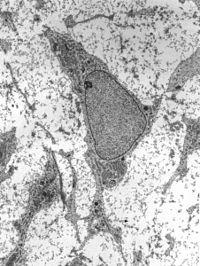
Photo from wikipedia
The osteopontin (OPN) released from mesenchymal stem cells (MSCs) undergoing lineage differentiation can negatively influence the expansion of hematopoietic stem cells (HSCs) in coculture systems developed for expanding HSCs. Therefore,… Click to show full abstract
The osteopontin (OPN) released from mesenchymal stem cells (MSCs) undergoing lineage differentiation can negatively influence the expansion of hematopoietic stem cells (HSCs) in coculture systems developed for expanding HSCs. Therefore, minimizing the amount of OPN in the coculture system is important for the successful ex vivo expansion of HSCs. Toward this goal, a bioengineered three dimensional (3D) microfibrous‐matrix that can maintain MSCs in less OPN‐releasing conditions has been developed, and its influence on the expansion of HSCs has been studied. The newly developed 3D matrix significantly decreased the release of OPN, depending on the MSC culture conditions used during the priming period before HSC seeding. The culture system with the lowest amount of OPN facilitated a more than 24‐fold increase in HSC number in 1 week time period. Interestingly, the viability of expanded cells and the CD34+ pure population of HSCs were found to be the highest in the low OPN‐containing system. Therefore, bioengineered microfibrous 3D matrices seeded with MSCs, primed under suitable culture conditions, can be an improved ex vivo expansion system for HSC culture.
Journal Title: Biotechnology and Bioengineering
Year Published: 2022
Link to full text (if available)
Share on Social Media: Sign Up to like & get
recommendations!